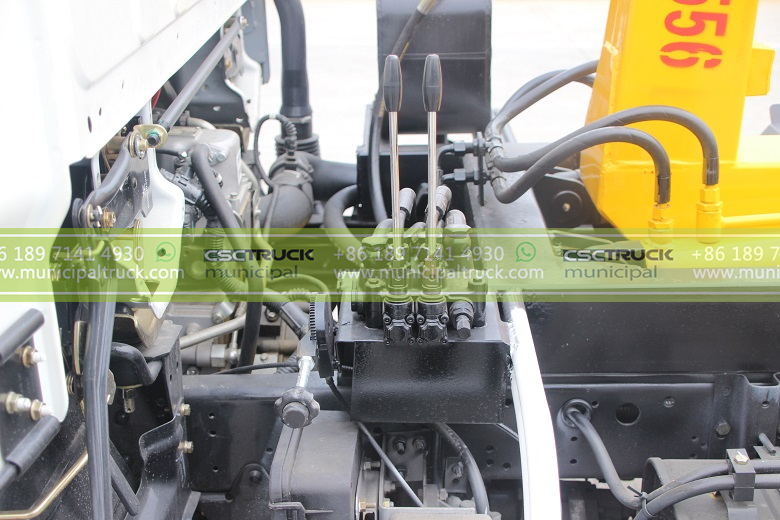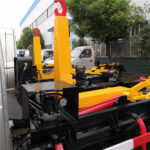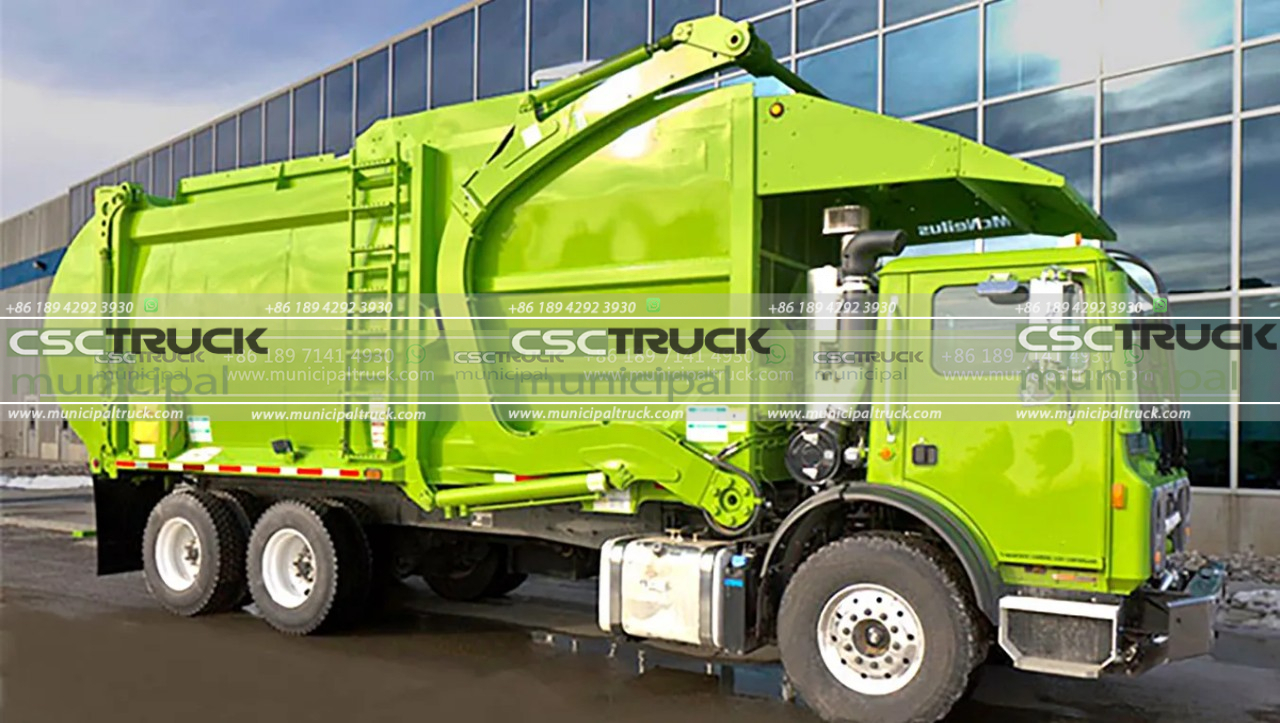The Unseen Muscle Behind Urban Sanitation
Imagine an early morning city street: a garbage truck pulls up beside a large, full commercial dumpster. Effortlessly, an arm extends, hooks onto the container, lifts it high into the air, pivots it over the truck’s hopper, and releases its contents. Within moments, the dumpster is back on the ground, and the truck moves on. This seemingly simple ballet of heavy lifting and precise motion appears effortless, yet it masks an intricate and powerful technological marvel – the hydraulic system. Serving as the indispensable muscle and nervous system of the hook loader garbage truck, this closed-loop network of fluid power enables the demanding task of efficiently collecting large volumes of waste from commercial dumpsters, day in and day out.
Hydraulic Fundamentals – The Language of Fluid Power
At its core, a hydraulic system operates on the immutable principle of Pascal’s Law: pressure applied to a confined fluid is transmitted undiminished in every direction throughout the fluid. This fundamental physics translates into practical, immense force multiplication essential for lifting heavy loads like fully laden refuse containers weighing several tons. The system is a closed circuit, meaning the hydraulic fluid is constantly recirculated, pressurized, and returned within sealed components, minimizing external contamination and ensuring consistent performance even under the strenuous, dirty conditions inherent to waste collection operations. The vital lifeblood of this system is the hydraulic fluid, a specialized oil engineered to withstand high pressures (often exceeding 3,000 psi), wide temperature fluctuations, and the constant threat of moisture ingress and particulate contamination, all while providing essential lubrication to the system’s moving parts and efficiently transferring energy with minimal loss. This fluid, contained within a reservoir tank, is the medium through which power travels silently from the source to the working cylinders and motors.
Core Components – The Anatomy of Motion
Transforming engine power into hydraulic force requires a sophisticated orchestra of components, each playing a critical role:
- The Power Source – Hydraulic Pump: Driven directly by the truck’s engine, typically via a power take-off (PTO) unit, the hydraulic pump acts as the system’s heart. Its primary function is to convert mechanical energy into hydraulic energy by drawing fluid from the reservoir and forcing it under high pressure into the system’s lines. Gear pumps are common due to their durability and cost-effectiveness for the constant pressure demands of hook loader operations, constantly supplying the flow needed for lifting, tilting, and compacting actions.
- Directing the Flow – Control Valves: Functioning as the brain and nervous system, sophisticated directional control valves dictate the precise movement of the loader arm and hopper functions. Operated by the driver from the cab console via levers or switches, these valves open and close specific pathways for the pressurized fluid. Complex spool valves meticulously meter the flow, determining the speed and direction of the hydraulic cylinders. Relief valves are integrated as critical safety components within this assembly, preventing catastrophic system failure by diverting fluid back to the reservoir if pressure surges beyond safe limits, such as during an overload condition or a hydraulic line blockage.
- Creating Motion – Hydraulic Actuators: This is where hydraulic pressure performs tangible work. Hydraulic cylinders are the primary linear actuators in a hook loader system. The main lift cylinder provides the immense brute force required to hoist the loaded container vertically. Smaller, carefully positioned cylinders control the intricate curling motion of the hook arm to engage the container’s lifting points and the precise tilting movement over the hopper. These cylinders contain a piston that moves within a barrel; pressurized fluid acting on one side of the piston forces it to extend or retract the rod, directly translating fluid power into powerful mechanical motion.
- The Supporting Network: Essential auxiliary components maintain system integrity. Steel-reinforced or high-pressure thermoplastic hydraulic hoses and steel tubing form the arteries and veins, safely channeling high-pressure fluid throughout the truck’s frame between moving components. Filters are strategically placed to continuously cleanse the fluid of abrasive particles that cause premature wear. The reservoir tank stores the fluid volume, allows air bubbles to escape, and facilitates heat dissipation to maintain optimal operating temperatures crucial for longevity.
The Hook Loader Mechanism – Precision Hydraulics in Action
The unique genius of the hook loader garbage truck lies in its specialized hydraulic sub-system designed for container handling. This isn’t just brute force; it’s controlled, intelligent power application. The sequence exemplifies hydraulic precision:
- Hook Engagement: The driver positions the truck and initiates the loader arm extension. Smaller auxiliary cylinders precisely maneuver the hook assembly to latch onto the container’s lifting bar. This requires fine control, provided by the valving sensitivity.
- The Critical Lift: Once securely hooked, the main lift cylinder is energized. Pressurized fluid enters the cylinder’s base port, driving the piston rod outwards with tremendous force. This rod, connected directly to the loader arm linkage, lifts the container vertically. The system’s pressure capability determines the maximum lift capacity, while flow rate dictates the lifting speed.
- Pivoting & Tip-Over: As the container clears obstacles, secondary cylinders come into play. These pivot the entire assembly over the truck’s hopper. Fluid flow is meticulously directed to ensure a smooth, controlled arc. Precise metering prevents a violent slam as the container reaches its tipping point directly above the hopper.
- Dumping & Return: A dedicated tilt cylinder (or a specific function on the main lift) then angles the container, allowing gravity to empty the contents into the hopper below. The valves then reverse flow, retracting the cylinders in sequence – lowering, pivoting back, and retracting the arm – to gently deposit the now-empty container back on the ground. Throughout this entire complex cycle, hydraulic power provides smooth, controlled motion essential for safety and minimizing container damage, despite the heavy loads and dynamic stresses involved.
Ensuring Longevity & Evolution – Maintenance and Comparative Context
The relentless duty cycle of a hook loader garbage truck imposes severe demands on its hydraulic system. Proactive maintenance is non-negotiable for reliability. Regular fluid analysis and changes are paramount, as degraded or contaminated fluid is the leading cause of component failure. Filter changes according to strict schedules prevent abrasive wear in pumps and valves. Vigilant inspection of hoses for abrasions, cracks, or bulges is critical to prevent sudden, dangerous leaks under pressure. Checking and tightening fittings prevents leaks and air ingress. Seal integrity on cylinders must be monitored; leaks not only create mess and environmental hazards but also reduce system efficiency and potentially lead to cylinder scoring. Preventative maintenance, adhering strictly to the manufacturer’s guidelines, significantly extends the service life of this expensive and operationally critical system, minimizing costly downtime during crucial collection routes.
While the hydraulic principles remain consistent, the implementation varies significantly based on the garbage truck’s core function. The hook loader garbage truck relies predominantly on powerful cylinders for container manipulation. In contrast, a compactor garbage truck utilizes its hydraulics primarily to actuate a massive crushing ram within its body, generating immense pressures (often exceeding 1,000 tons) to densify loose refuse, maximizing payload capacity per trip; this application demands exceptionally robust pumps and valves designed for sustained high-pressure compaction cycles. Similarly, a self tipper garbage truck (often a rear-loader or side-loader) employs hydraulics to lift its entire cargo body at the landfill or transfer station, using large cylinders mounted at the rear or sides to pivot the body upwards for gravity-based unloading; the hydraulic requirements focus on generating sufficient torque for lifting the entire loaded body rather than the intricate container manipulation of the hook loader. Understanding these distinctions highlights the specialized engineering behind each waste collection solution’s hydraulic architecture, all aimed at maximizing efficiency, payload, and reliability in the demanding world of solid waste management. The silent fluid power coursing through these machines remains the indispensable force keeping our urban environments clean.







